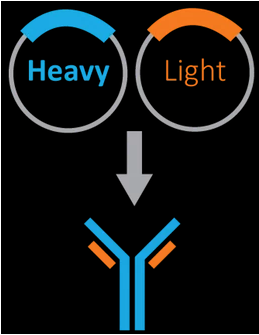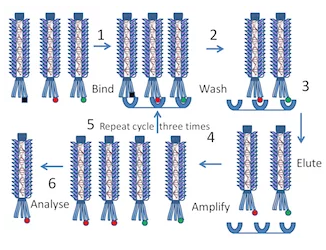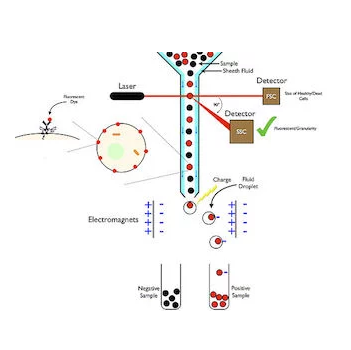
Antibody Basics: Recombinant Antibodies
Antibody development works much like any engineering feat; you get out what you put in. With the shotgun approach to developing polyclonal antibodies, hitting the target usually isn’t too much of a problem, but the immune response can be nonspecific. Additional techniques can be performed to create monoclonal antibodies through hybridoma development, but they’re still kept in a biological system that can potentially mutate, changing the antibody’s sequence and specificity. Recombinant antibodies take development techniques even further, drawing the DNA out of the living system and preserving it in an expression vector and gathering sequence data on the exact antibody’s gene. This DNA can be altered to express the same binding domain on different isotypes or can be used to express antibody fragments of different sizes.
How it works
Recombinant antibody development can take a few routes to reach the same goal. The three most common methods of development used in the industry include display systems, direct B-cell cloning, or the use of pre-existing hybridomas.
The goal of each of these systems is not only to isolate the antibody of interest but to collect data on its gene sequence so it may be reproduced.

Development Through Display Systems
Display systems, including yeast and phage display, follow a very involved process in which a wide variety of antibody binding domains are expressed as membrane surface or viral coat proteins. The antibody binding domain is “displayed” where it is able to bind to an antigen while the genetic material corresponding to that domain is kept inside the display system. Panning and washing of the display systems allow for the filtering away of unwanted genes, isolating the antibody of interest. Once the gene is isolated, it can be studied and used to produce more antibodies in other expression hosts.

Development Through Direct B-cell Cloning
Direct B-cell cloning involves isolating B-cells from a host for the generation of recombinant antibodies. B-cells are first sorted from whole blood or other tissues and separated from one another using flow cytometry. The separated cells are screened to find clones producing desirable antibodies, and those genes are amplified in PCR. The DNA is then sequenced and can be used to develop the corresponding recombinant antibody in an expression host. This process is actually used by many companies for the development of rabbit monoclonal antibodies.
Development from Pre-existing Hybridomas
Developing recombinant antibodies from pre-existing hybridomas is almost identical to that of B-cell cloning, except the development and screening have already been completed. With isolated hybridomas, all that’s needed is to isolate the genes corresponding to the antibody of interest. Once the antibody gene is collected and sequenced, it can be put into an expression system to continue producing the desired antibody with the same benefits as other recombinant antibodies.
Once the development of recombinant antibodies is complete, they are easily produced in large volumes and provide more reliable binding activity than most pAbs and many mAbs. Though these development processes are very detailed, time-consuming, and often expensive, it can make a world of difference when an antibody needs to work every time in a specific application, especially if the application is going to be performed several times over a long period of time.
References:
- Frenzel, André, et al. “Expression of Recombinant Antibodies.” Frontiers in Immunology.
Frontiers Media S.A., 7 July 2013. Web. 19 Oct. 2016 - Offner, Sonja, et al. “A Robust High Throughput Platform to Generate Functional Recombinant
Monoclonal Antibodies Using Rabbit B Cells from Peripheral Blood.” PLOS ONE. PLOS
ONE, 4 Feb. 14. Web. 19 Oct. 2016.
Originally posted by ProSci: www.prosci-inc.com/blog/recombinant-antibodies/
